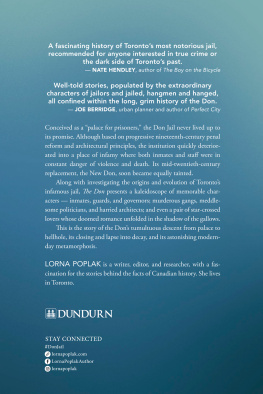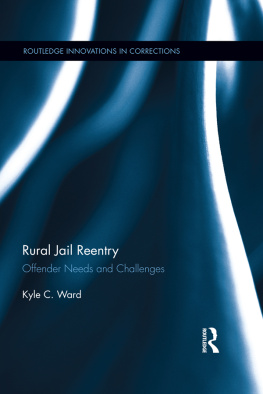Contents
Guide
THE DON
THE DON
The Story of Torontos Infamous Jail
LORNA POPLAK

Copyright Lorna Poplak, 2021
All rights reserved. No part of this publication may be reproduced, stored in a retrieval system, or transmitted in any form or by any means, electronic, mechanical, photocopying, recording, or otherwise (except for brief passages for purpose of review) without the prior permission of Dundurn Press. Permission to photocopy should be requested from Access Copyright.
Publisher: Scott Fraser | Acquiring editor: Kathryn Lane | Editor: Dominic Farrell
Cover designer: Sophie Paas-Lang
Cover image: Gary Cross
Printer: Marquis Book Printing Inc.
Library and Archives Canada Cataloguing in Publication
Title: The Don : the story of Torontos infamous jail / Lorna Poplak.
Names: Poplak, Lorna, author.
Description: Includes bibliographical references and index.
Identifiers: Canadiana (print) 9781459745964 | Canadiana (ebook) 20200333135 | ISBN 9781459745964 (softcover) | ISBN 9781459745971 (PDF) | ISBN 9781459745988 (EPUB)
Subjects: LCSH: Don Jail (Toronto, Ont.)History. | LCSH: JailsOntarioTorontoHistory.
Classification: LCC HV8746.C32 T67 2021 | DDC 365/.9713541dc23

We acknowledge the support of the Canada Council for the Arts and the Ontario Arts Council for our publishing program. We also acknowledge the financial support of the Government of Ontario, through the Ontario Book Publishing Tax Credit and Ontario Creates, and the Government of Canada.
Care has been taken to trace the ownership of copyright material used in this book. The author and the publisher welcome any information enabling them to rectify any references or credits in subsequent editions.
The publisher is not responsible for websites or their content unless they are owned by the publisher.
VISIT US AT
 dundurn.com
dundurn.com
 @dundurnpress
@dundurnpress
 dundurnpress
dundurnpress
 dundurnpress
dundurnpress
Dundurn
3 Church Street, Suite 500
Toronto, Ontario, Canada
M5E 1M2
For my family
No one truly knows a nation until one has been inside its jails. A nation should not be judged by how it treats its highest citizens but its lowest ones.
Nelson Mandela
Prison is essentially a shortage of space made up for by a surplus of time; to an inmate, both are palpable.
Joseph Brodsky
CONTENTS
AUTHORS NOTE
T hroughout this book, I usually refer to the historic building that forms its focus as the Don Jail. However, as will be seen from direct quotes included in the text, early sources more often than not called it a gaol, which is a variant and now archaic word for jail. For other correctional institutions, I have followed the generally accepted usage: whereas Chatham, Ontario, had a jail, for example, there were gaols in both Ottawa and Goderich.
All sources agree that construction of the Don Jail started in 1858; there is less consensus on when it ended. Over time, conventional wisdom has suggested that the building was completed and opened in 1865. However, archival newspaper reports point to 1864 as the completion date. As this has been corroborated by several authoritative modern sources, I have accepted 1864 as the year when the Don welcomed its first occupants.
It will be noticed that news items from the nineteenth century sometimes quote prices in pounds and sometimes in dollars. The British pound was the official unit of currency in British North America from as early as 1763. In 1853, legislation in the Province of Canada (now Ontario and Quebec) provided that official accounts could be kept in both pounds and dollars. From 1857 the dollar became the official currency in Canada, although merchants continued to use whichever currency they preferred until well into the 1870s. Throughout the whole period, the pound was worth four dollars. When pounds are used in archival news reports, I have provided the dollar equivalent in square brackets.
The Toronto city council was instrumental in the establishment of the jail in the 1850s. Over the years, it also played a vital role in its funding and supervision. Members of the city council were initially called aldermen; only in 1989 did they become known as councillors not in the interests of gender neutrality, as might be expected, but to comply with changes introduced in the provincial Municipal Act.
Early European travellers and settlers in what is now known as Toronto fearfully documented a silent disease characterized by agues [shivering fits] and intermittent fevers that ravaged the population each year. One writer in the early 1800s claimed that possibly five-sevenths of the populace was afflicted. Although these agues and fevers were originally attributed to a foul-smelling and poisonous vapour called a miasma that was released, mainly at night, it is now accepted that the cause was malaria, which was prevalent in Ontario at the time. As I write, another silent and exceptionally deadly airborne killer is wreaking havoc on communities around the globe. It is my fervent hope that viable therapies will soon be developed, as well as a vaccine to stop the spread of this lethal pandemic. In the meantime, I salute all those who risk their lives to keep ours safe.
INTRODUCTION
O n December 31, 1977, the correctional services minister of Ontario rang out the old year with a sledgehammer blow to the cornerstone of an old building on the east side of the Don River in Toronto. He was not alone: another senior correctional services official and a well-known activist also took a crack at it. Watched by television crews, newspaper reporters, politicians, police officers, jail superintendents, and a few bemused members of the public, they finally managed to chip away a one-foot-square piece of stone from the buildings faade.
The target of all this negativity was the infamous Toronto Jail, also known as the Toronto gaol, the Don Jail, the Old Don, or, simply, the Don. It was not the first time that this institution, located at the northwest corner of Gerrard Street East and Broadview Avenue, had been assailed during its 113-year lifespan, but previous attacks had been verbal rather than physical. The jail had been variously called a lions den, a black hole of Calcutta, Torontos Bastile [sic], or worse. The correctional services minister liked to call it a monument to human misery in the early barbaric style.
Very occasionally, on the other hand, the Don Jail had been lauded as a veritable palace for prisoners, incorporating the finest and most progressive of correctional philosophies. This was certainly true in the mid-1800s, when the building was conceived and constructed.
The Don, Torontos fourth jail, opened its doors to its first reluctant residents in 1864, predating the Confederation of Canada by three years. It originally stood remote from the city on the wrong side of the Don River, the meandering and strategically significant waterway that spilled into Lake Ontario just east of where a tiny settlement had been established in 1793 by British colonists in what was then the newly formed province of Upper Canada.










 dundurn.com
dundurn.com @dundurnpress
@dundurnpress dundurnpress
dundurnpress dundurnpress
dundurnpress